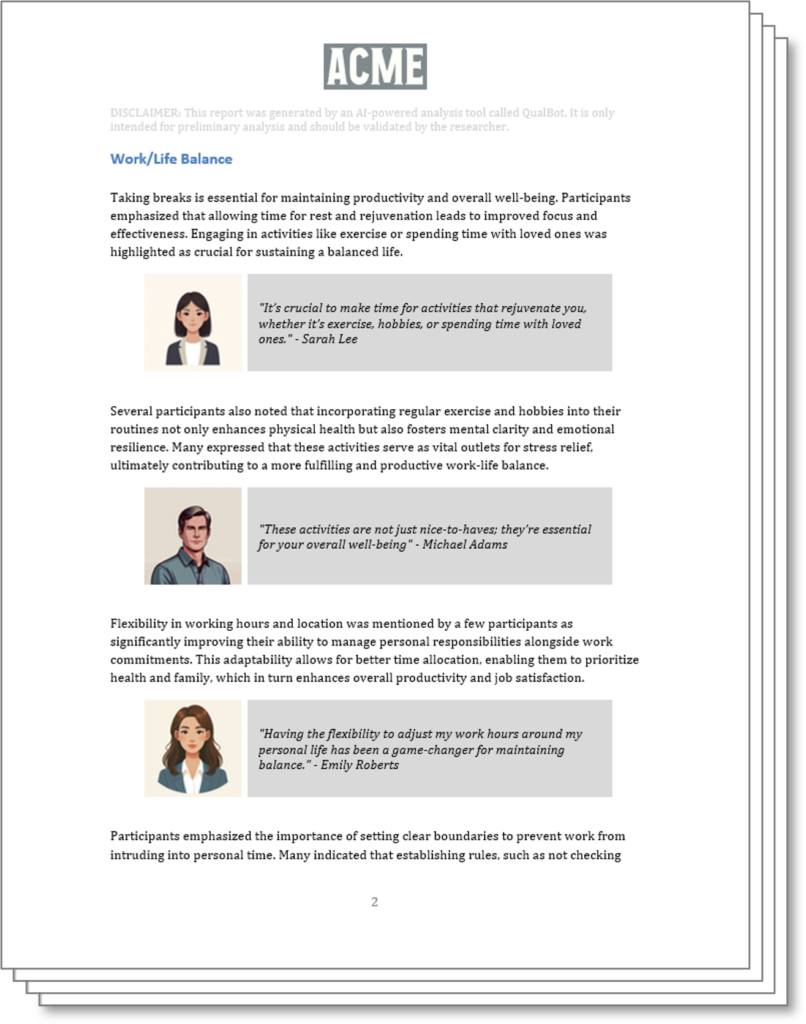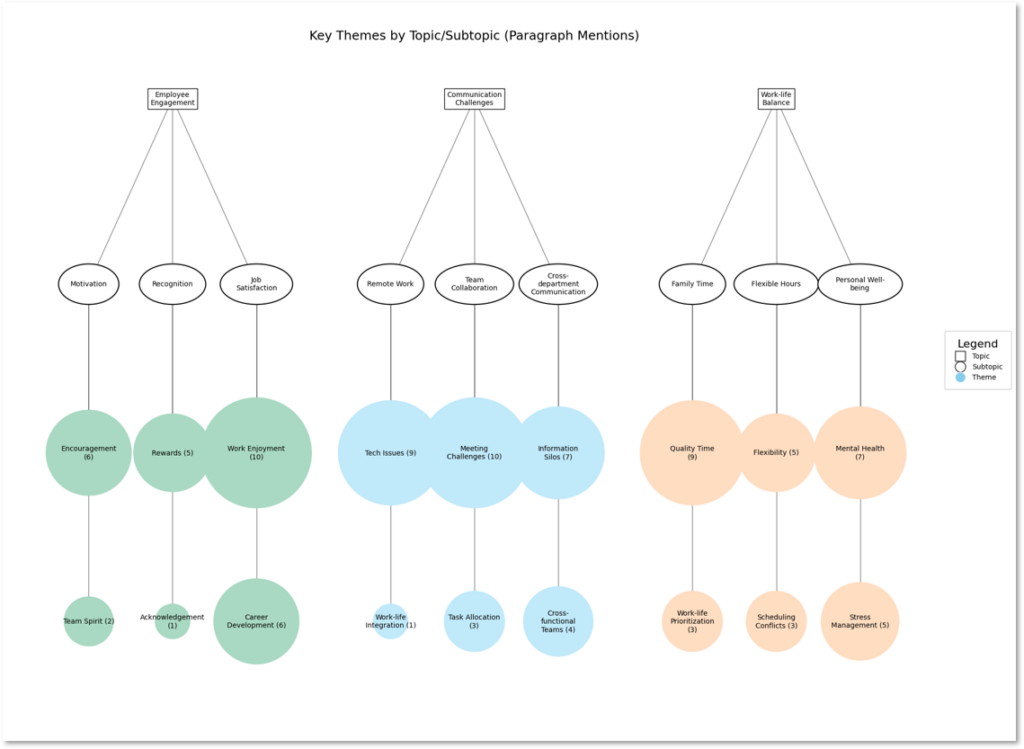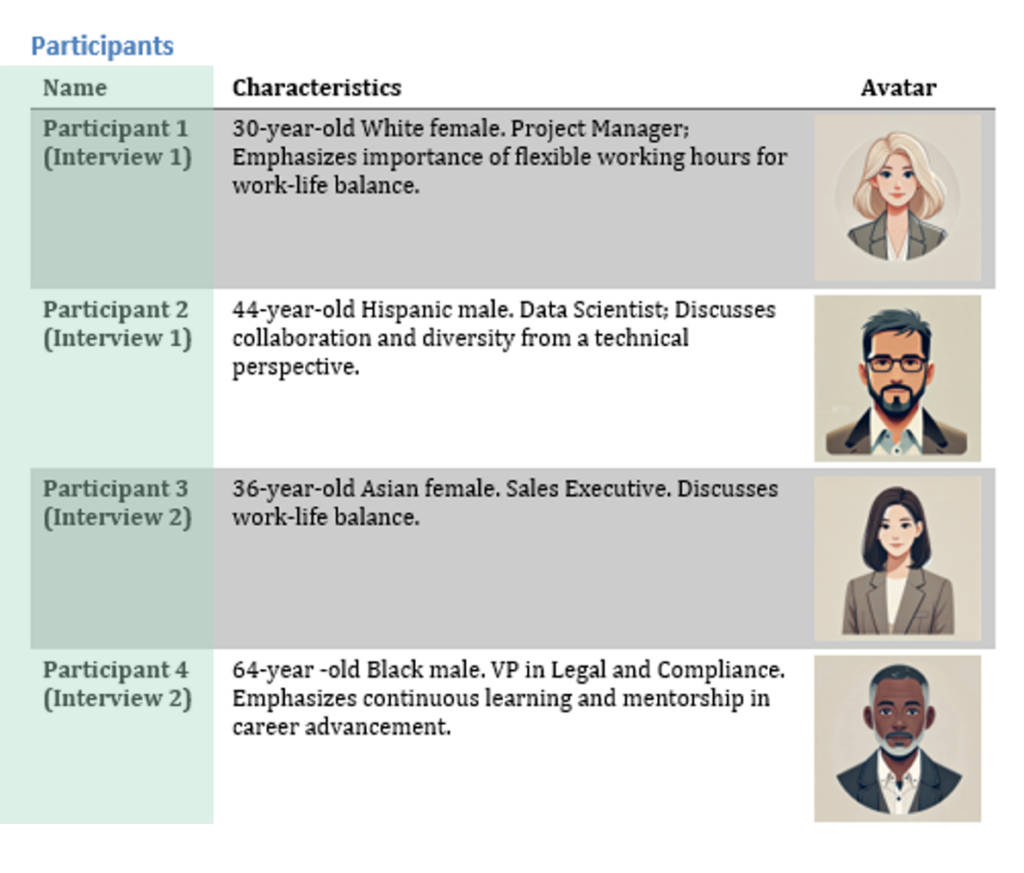In my 20 years of research experience I have seen all kinds of reports in all kinds of formats. Novel-length MS Word documents with page after page of text walls. Snazzy, custom-designed dashboards with interactive graphs and other bells and whistles. Narrative video reports supported by flying slides (remember Prezi?)…
All of these formats can work well, as long as they convey a compelling story. The best reports don’t just present findings—they engage stakeholders, spark further questions, and make their insights impossible to ignore. Visual elements are important, but equally crucial are carefully selected verbatim quotes that reinforce your themes, along with tailored report customization to effectively reach your stakeholders.
In this post, we’ll explore how you can leverage features like AI-generated respondent avatars, theme-specific verbatim quotes, codebook visualizations, and multilingual support to create dynamic, impactful qualitative reports using QualBot.
1.Using AI-Generated Respondent Avatars
While verbatim quotes help to provide credibility and nuance to your themes, it would be even better to see the respondent’s face attached to the quote. However, for privacy reasons, we typically are constrained from showing pictures of respondents. Enter the AI avatar! AI-generated avatars can represent participants in a way that adds visual engagement without compromising privacy. AI-generated avatars add a human touch to your reports, creating a visual connection to respondents while maintaining their anonymity.
QualBot generates AI-avatars to provide a more immersive, engaging experience for report readers. QualBot’s integration with AI tools allows you to create respondent avatars that reflect the demographics of your participants without the need for actual photos.
2.The Power of Verbatim Quotes
As researchers we need to constantly battle the tension between specificity and generality. If we focus on the specifics of any one interview, we risk getting mired in individual details that may not matter to our broader story. If we go to the other extreme, and only focus on generalizable findings, we risk losing authenticity and emotional appeal.
In thematic analysis, verbatim quotes from participants are a great way to bring broader themes to life by letting the respondents speak for themselves. Choosing good quotes is critical though. A good verbatim should both speak to a broader theme and provide enough vivid detail to be memorable and compelling, hopefully adding nuance and color to the theme.
However finding good quotes is like finding the proverbial needle in the haystack. Typical interview transcript may have between 5,000 and 20,000 words, and an entire research project, including 10 or more interviews, will be north of 100,000 words. General-purpose LLMs struggle pulling relevant quotes from context windows, if they allow them at all. Quotes may not be directly relevant, or even worse, may be hallucinations.
QualBot uses an agentic workflow including semantic indexing and retrieval augmented generation to identify quotes for each theme in your data. QualBot’s approach guarantees that quotes closely align with themes and are actually literal verbatims. These quotes are automatically formatted and paired with participant avatars reflecting demographic characteristics of your respondents for a more engaging reader experience.
3. Visualizing Your Codebook
When dealing with complex qualitative data, it’s easy to get lost in text-heavy reports. Codebook visualization can make this data more accessible by clearly showing the relationships between topics, subtopics, and specific themes. A tree diagram offers a structured, intuitive view of how your analysis is organized, helping readers understand the “big picture” and quickly grasp the structure of your report.
QualBot simplifies the creation of these detailed visualizations. Using AI, it automatically generates hierarchical tree diagrams where theme bubbles are sized according to the number of paragraphs and interviews in which they were mentioned. This dynamic representation not only saves you time but also ensures your visualizations are both accurate and impactful.
In this example, the tree diagram visualizes themes as bubbles, where the size of each bubble is proportional to the number of paragraphs and interviews in which that theme was mentioned. This not only shows the relative importance of each theme but also provides a visual cue for its prevalence across different respondents. By visualizing both the hierarchical structure of your themes and their relative prominence, you ensure your analysis is clear, concise, and engaging for your stakeholders.
4. Leveraging multilingual capabilities
In today’s interconnected world, qualitative research often spans multiple regions and languages. To meet the diverse needs of global stakeholders, it’s critical to be able to analyze data and present findings in multiple languages. QualBot allows you to generate reports in 11 major languages, ensuring that your insights are accessible to a wide range of audiences. Whether you’re reporting to stakeholders in Europe, Asia, the Middle East, or the Americas, QualBot’s multilingual capabilities enable you to seamlessly deliver high-quality, localized reports without the hassle of manual translation.
Language diversity isn’t just about translating reports—it’s also about analyzing transcripts in the language they were collected. QualBot’s AI is built to handle transcripts in multiple languages, allowing you to analyze interviews or focus group discussions without worrying about losing nuances due to language barriers. Whether your data is in English, Spanish, Arabic, or beyond, QualBot can process and analyze it, providing accurate thematic analysis and verbatim quotes in the original language.
We understand that every research project is unique, and sometimes your language of choice may not yet be available. That’s why we’ve made it easy for you to request additional languages. If you don’t see your language listed in QualBot’s current offerings, let us know! We’re committed to expanding our multilingual capabilities to support your needs and will work diligently to add the language you need for your project.
5. Anonimization
Confidentiality is at the heart of qualitative research. In many cases, ensuring the privacy of participants is not only a matter of ethical responsibility but also a legal requirement. QualBot automatically anonymizes participant details, replacing identifying information such as names with generic labels.
Anonymization doesn’t mean losing track of who said what. QualBot retains full traceability by linking demographic information—such as age, gender, and profession—to anonymized participants. This approach allows you to highlight important characteristics without compromising privacy, giving readers a more complete understanding of the context behind each quote. Each verbatim quote is fully traceable to the respondent’s demographic profile, so readers can appreciate the perspectives of specific segments, such as age groups or professional backgrounds, without knowing the participant’s identity.
Qualitative research reports should do more than just present data—they should tell a story, engage stakeholders, and drive action. By incorporating features such as AI-generated avatars, carefully selected verbatim quotes, codebook visualizations, multilingual support, and anonymization, QualBot will make your reports more dynamic and visually compelling, while ensuring accuracy, relevance, and anonymity.
In a world where attention is scarce and insights need to be impactful, QualBot gives you the tools to create reports that leave a lasting impression. Whether you’re delivering insights to a global audience, ensuring privacy, or simply trying to make your data more digestible, QualBot has you covered.
Try it now: https://app.qualbot.io/





